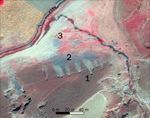Small scale mining, environmental protection and law

Munich, 24 September 2012
IES, in a team together with GAF AG and DLR, is carrying out a contract to use optical and radar remote sensing sensors and interpretation techniques to locate, map and monitor small-scale and artisanal mining (ASM) operations. In many countries, information about ASM is largely incomplete and, as a consequence, ASM activities remain informal and outside of governmental supervision and regulation.
Especially in remote, poorly accessible or security sensitive areas, satellite-based remote sensing is the most efficient tool for area-wide mapping and monitoring. In this project, very high resolution optical image data, stereo data and radar-based coherence analysis is being applied and interpreted together with other geo-data such as mining cadastre information. This involves the following information being extracted from earth observation images for monitoring ASM activities:
- location and description of mining activities (activity maps and disturbed terrain analysis e.g. trenches, pits, stockpiles) and change detection
- rough estimation of extracted material
- infrastructure (e.g. processing plants, transportation routes) and influx/efflux of population
This information is used to create up-to-date reconnaissance maps and dossiers with a description of current mining activities in order to facilitate the work of in-situ mines inspectors. In addition, a methodology for country-wide mines verification is being developed.
The project covers a range of settings with artisanal mining for metals, coal, gold, gemstones as well as quarries in several selected pilot areas. Cases are selected from GAF's international activities within the mineral resources domain; recent GAF project countries include Guyana, Morocco, Ivory Coast, Nigeria, Uganda, Madagascar, Afghanistan, Mongolia and Papua New Guinea.
Artisanal or small-scale mining is largely a poverty driven activity and is typically practiced in the poorest and most remote rural areas of countries by a largely itinerant, poorly educated populace with little else available in the way of alternative employment. Today, an estimated 13 million people in about 30 countries across the world are small-scale/artisanal miners, with about 80 - 100 million people depending on such mining for their livelihoods. ASM can be environmentally damaging and often has serious health and safety consequences for workers and surrounding communities. Many of the potential economic benefits of the small-scale mining sector are also lost as a result of poor practice with regard to mining, processing and marketing. The compiling of an inventory is a first step towards regularizing the sector, i.e. the enforcement of health, safety and environmental standards and the collection of royalties. Governments can then also grant operators proper legal title and provide technical, marketing and training support.
The project is funded under the European Space Agency (ESA) "Timely Situation Awareness for Law Enforcement and Intelligence Application" contract, which forms part of the Value Added Element (VAE) programme. The purpose of the VAE programme is to support industry in the use of earth observation data. The project started in autumn 2011 and is scheduled to run for 18 months.